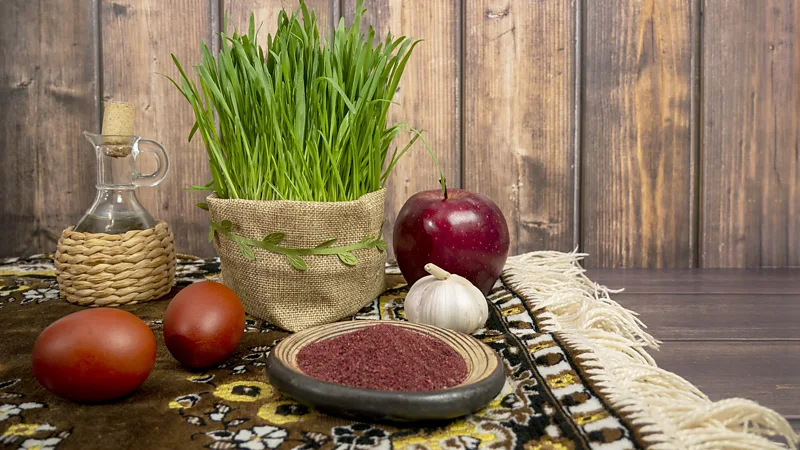Nowruz: A Celebration of Renewal, Unity, and Nature’s Rebirth
Nowruz, also known as the Persian New Year, is a vibrant celebration observed by millions around the world. It marks the beginning of spring, a time of renewal, growth, and optimism. This essay delves into the rich history, traditions, and cultural significance of Nowruz, exploring its enduring legacy and how it continues to connect people across generations and geographical boundaries.
A History Steeped in Tradition: From Ancient Roots to Modern Celebration
The origins of Nowruz stretch back millennia, with roots in ancient Mesopotamia. Early civilizations like the Babylonians celebrated the spring equinox, marking the start of a new agricultural year and a time of renewed hope. The Achaemenid dynasty in Persia (550-330 BCE) formalized the celebration, establishing Nowruz as a national holiday.
Zoroastrianism, an ancient Iranian religion emphasizing dualistic principles of good and evil, further shaped the traditions of Nowruz. Elements like fire, symbolizing purification and light, and water, representing life and renewal, became central to the rituals. Even after the Islamic conquest of Persia in the 7th century CE, Nowruz remained a cherished tradition, seamlessly blending with Islamic practices.
Today, Nowruz transcends religious affiliation, serving as a unifying cultural experience for diverse communities.
The Rituals of Nowruz: Embracing Renewal and Joy
Leading up to Nowruz, a period of preparation known as “Khana Takani” (house cleaning) takes place. Homes are thoroughly cleaned, symbolizing the removal of negativity and the welcoming of new beginnings. Families gather to prepare the Haft Sin (Seven S’s) table, a symbolic centerpiece of the celebration.
Each item on the Haft Sin table carries a specific meaning:
- Sabzeh (sprouts): representing rebirth and new life.
- Samanu (wheat pudding): symbolizing prosperity and sweetness.
- Senjed (dried lotus berries): representing love and longevity.
- Sir (garlic): representing health and protection.
- Sumaq (sumac): representing the color red, symbolizing the dawn and victory of good over evil.
- Sib (apples): representing beauty and health.
- Serkeh (vinegar): representing patience and wisdom.
Other traditional elements include Haft Sin poems, symbolizing blessings and wishes for the coming year, and decorative eggs, often painted with intricate designs.
Nowruz Celebrations: A Time for Family, Fun, and Feasting
The first day of Nowruz, coinciding with the spring equinox, is a joyous occasion. Families and friends gather for elaborate feasts featuring traditional dishes like Sabzi Khordan (fresh herb platter), Dizi (stew), and Ash Reshteh (noodle soup). Children receive gifts and money in red envelopes called “Eidi.” Firecrackers are lit, symbolizing the banishing of darkness and evil. Traditional music fills the air, and some celebrate by jumping over bonfires, a ritual believed to cleanse negativity.
Chahar Shanbeh Suri (Fire Wednesday), the last Wednesday before Nowruz, is observed with bonfires and jumping over the flames, symbolizing purification and renewal. Sizdah Bedar (Thirteenth Day Out), observed thirteen days after Nowruz, involves spending time outdoors in parks and gardens, enjoying nature’s beauty and the spring weather.
Beyond Iran: A Global Celebration of Unity
Nowruz is not confined to Iran. It is celebrated by communities with Iranian heritage in countries like Afghanistan, Tajikistan, Azerbaijan, Turkey, Iraq, and across Central Asia. The diaspora communities keep the traditions alive, fostering cultural identity and a sense of belonging.
Nowruz has also been recognized by the United Nations as an international holiday, highlighting its cultural significance and fostering global understanding.
The Durable Heritage of Nowruz
There is more to Nowruz than just ringing in the new year. It’s evidence of the continuing value of customs, which serve as a reminder of ancestry and community. It emphasizes the value of environmental equilibrium and the cyclical rhythm of existence, cultivating a strong bond with the natural world. The focus placed on forgiveness, gift-giving, and family get-togethers enhances social ties and a sense of community.
Nowruz and Modern Challenges: Adapting Traditions in a Changing World
The 21st century presents new challenges to the observance of Nowruz. Globalization, urbanization, and busy lifestyles can make upholding traditional rituals difficult. However, communities find innovative ways to adapt traditions. Social media platforms allow geographically dispersed families to connect and share the spirit of Nowruz. Environmental concerns lead to the adoption of eco-friendly practices, like using symbolic substitutes for live sprouts on the Haft Sin table.
Conclusion: A Celebration that Bridges the Past and Future
Nowruz remains a vibrant and dynamic celebration, constantly evolving while retaining its core values of renewal, unity, and connection to nature. It serves as a reminder of the importance of traditions, family, and cultural heritage. Nowruz bridges the past and future, bringing people together in a celebration of hope, joy, and the promise of a new beginning.
